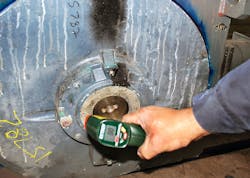Maximum temperature ratings are based on the motor’s insulation system class and apply to the winding temperature at the hottest spot inside the motor. As a general rule, the frame can be 20°C to 40°C cooler (less or more), depending on the design and the enclosure. Still, with some modern insulation systems, the surface temperature of the motor could be hot enough to burn your fingers or hand. Thus, using caution is in order. Never use a part of your body to check the temperature of a motor. Always use a temperature-detection device, such as the one shown in the Photo.
To illustrate how hot a frame can get, assume a high-efficiency motor design with Class F (155°C) insulation has a 40°C ambient temperature and operates with a Class B (130°C) temperature rise (i.e., a 90°C winding temperature rise). At full load, this means the total winding temperature would be about 130°C (90°C + 40°C), which is well below the 155°C design limit for the Class F insulation. Assuming the frame temperature is 40°C lower than the winding temperature (quite liberal), the surface temperature of the frame would be about 90°C (194°F). Suffice it to say, no one should touch a frame that hot.
Causes of excessive heat in the winding can be either external or internal to the motor. External causes include high ambient temperature, contaminants, mechanical overload, high inertia loads, high- or low-supply voltage, or unbalanced voltages. Causes of excessive winding temperature internal to the motor include contaminants that build up in the motor or that block ventilation passages and missing or damaged air deflectors or fans.
About the Author
Tom Bishop, P.E.
Senior Technical Support Specialist
Bishop, P.E., joined the staff of the Electrical Apparatus Service Association (EASA) following more than 30 years of engineering experience at electrical machinery manufacturers and electrical apparatus service firms. Holding a BS in electrical engineering and a professional engineer’s license, Bishop has authored dozens of technical articles and papers as well as presented numerous seminars on electric motor application, maintenance, and repair. He is chairman of EASA’s Technical Services Committee and a principal member of the National Fire Protection Association Electrical Equipment Maintenance Committee (NFPA 70B).
